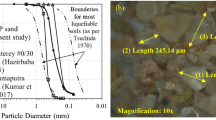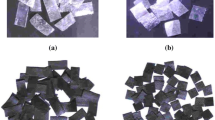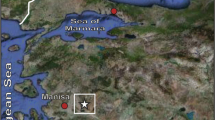Abstract
Estimation of dynamic properties and cyclic strength becomes necessary with urbanization, for land use, planning and development. In undrained conditions, during the application of the cyclic load, the excess pore water pressure is developed in the soil, and consequently, the cyclic strength of the soil degrades and ultimately liquefaction occurs in the soil. Several factors such as site characteristics (effective confining stress, saturation condition, reconsolidation, etc.) and motion characteristics (motion amplitude and frequency) can affect the dynamic properties as well as the liquefaction phenomenon of the soil. The dynamic properties and cyclic behavior of soil can be evaluated in the laboratory using cyclic triaxial apparatus. In the laboratory, the soil behavior can be estimated either (a) by performing multiple single-stage tests or (b) by using a multistage test. Although the former procedure is more economical, the major concern is the microstructural changes during multistage testing. Therefore, as an alternative approach, a neural network-based modeling approach has been adopted in this study. The advantage of this research is that for quaternary alluvium sands with certain index properties, the proposed models can predict the cyclic behavior as well as the shear modulus of soil with significant accuracy under large strain. The database used to develop these models comprised 94 cyclic triaxial tests performed on quaternary alluvium sands with different confining pressure and loading characteristics. Results from different experimental observations are then used for validating the ANN models proposed in this study.














Similar content being viewed by others
Availability of data and material
All data, models or codes that support the findings of this study are available from the corresponding author upon reasonable request.
Code availability
No code was generated or used during the study.
References
Das, A., Chakrabortty, P.: Artificial neural network and regression models for prediction of free-field ground vibration parameters induced from vibroflotation. Soil Dyn Earthq Eng 148, 106823 (2021)
Das, S.K.: Artificial neural networks in geotechnical engineering: modeling and application Issues. In: Metaheuristics in Water Geotech Transp Eng. pp 231–267 (2013)
Goh, A.T.C.: Neural-network modeling of CPT seismic liquefaction data. J Geotech Eng 122, 70–73 (1996)
Kurup, P.U., Dudani, N.K.: Neural networks for profiling stress history of clays from PCPT data. J Geotech Geoenviron Eng 128, 569–579 (2002)
Shahin, M.A., Jaksa, M.B., Maier, H.R.: Recent advances and future challenges for artificial neural systems in geotechnical engineering applications. Adv Artif Neural Syst 2009, 1–9 (2009). https://doi.org/10.1155/2009/308239
Shahin, M.A., Maier, H.R., Jaksa, M.B.: Predicting settlement of shallow foundations using neural networks. J Geotech Geoenviron Eng 128, 785–793 (2002)
Zhang, P., Yin, Z., Jin, Y., Ye, G.: An AI-based model for describing cyclic characteristics of granular materials. Int J Numer Anal Methods Geomech 44, 1315–1335 (2020)
Das, A., Chakrabortty, P.: Simple Models for Predicting Cyclic Behaviour of Sand in Quaternary Alluvium. Arab J Geosci 15, 385 (2022). https://doi.org/10.1007/s12517-022-09639-6
Chakrabortty, P., Roshan, A.R., Das, A.: Evaluation of dynamic properties of partially saturated sands using cyclic triaxial tests. Indian Geotech J 50, 948–962 (2020). https://doi.org/10.1007/s40098-020-00433-3
Chattaraj, R., Sengupta, A.: Liquefaction potential and strain dependent dynamic properties of Kasai River sand. Soil Dyn Earthq Eng 90, 467–475 (2016)
Das, A., Chakrabortty, P.: Large strain dynamic characteristics of quaternary alluvium sand with emphasis on empirical pore water pressure generation model. Eur J Environ Civ Eng, pp 1–24 (2021b)
Das, A., Chakrabortty, P., Popescu, R.: Assessment of lumped particles effect on dynamic behaviour of fine and medium grained sand. Bull Earthq Eng 19, 745–766 (2021)
Hardin, B.O., Drnevich, V.P.: Shear modulus and damping in soils: design equations and curves. J Soil Mech Found Div 98, 667–692 (1972)
Kokusho, T.: Cyclic triaxial test of dynamic soil properties for wide strain range. Soils Found 20, 45–60 (1980)
Kumar, S.S., Krishna, A.M., Dey, A.: Parameters influencing dynamic soil properties: A review treatise. Int J Innov Res Sci Eng Technol An ISO 3, 47–60 (2014)
Das, A., Deb, R., Banerjee, S.: Prediction of Cyclic Behaviour of Quaternary Alluvial Soil using Finite Element Approach. In: 7th International Conference on Geotechnical Research and Engineering (ICGRE’22) (2022). https://doi.org/10.11159/icgre22.203
Kanth, A., Maheshwari, B.K.: Behaviour of Solani sand under monotonic and cyclic loading: experiments and finite element simulations. Int J Geotech Eng 16, 729–742 (2021). https://doi.org/10.1080/19386362.2021.1966225
Papadimitriou, A.G., Bouckovalas, G.D.: Plasticity model for sand under small and large cyclic strains: a multiaxial formulation. Soil Dyn Earthq Eng 22, 191–204 (2002)
Wang, G., Xie, Y.: Modified bounding surface hypoplasticity model for sands under cyclic loading. J Eng Mech 140, 91–101 (2014)
Seed, H. B., Idriss, I. M.: Soil moduli and damping factors for dynamic response analyses, Report No. EERC 70–10, Earthquake Engineering Research Center, University of California, Berkeley (1970)
Varghese, R., Amuthan, M.S., Boominathan, A., Banerjee, S.: Cyclic and postcyclic behaviour of silts and silty sands from the Indo Gangetic Plain. Soil Dyn Earthq Eng 125, 105750 (2019)
Das, A., Chakrabortty, P.: Simple Statistical Models to Predict the Cyclic Behaviour of Cohesionless Soil in Quaternary Alluvium. In: 3rd Conference of the Arabian Journal of Geosciences (3rd CAJG). pp 1–4 (2020)
Hazirbaba, K.: Pore pressure generation characteristics of sands and silty sands: a strain approach. Dissertation presented for Ph.D program to the faculty of Graduate School, University of Texas, Austin (2005)
Pain, A., Nimbalkar, S., Hussain, M.: Applicability of Bouc-Wen model to capture asymmetric behavior of sand at high cyclic shear strain. Int J Geomech 20, 6020009 (2020)
Zhu, J.H., Zaman, M.M., Anderson, S.A.: Modeling of soil behavior with a recurrent neural network. Can Geo J 35(5), 858–872 (1998)
Mustafa, M.R., Rezaur, R.B., Rahardjo, H., Isa, M.H.: Prediction of pore-water pressure using radial basis function neural network. Eng Geol 135, 40–47 (2012)
Ng, W., Minasny, B., Montazerolghaem, M., Padarian, J., Ferguson, R., Bailey, S., McBratney, A.B.: Convolutional neural network for simultaneous prediction of several soil properties using visible/near-infrared, mid-infrared, and their combined spectra. Geoderma 352, 251–267 (2019)
Rezaei, K., Guest, B., Friedrich, A., Fayazi, F., Nakhaei, M., Beitollahi, A., Fatemi Aghda, S.M.: Feed forward neural network and interpolation function models to predict the soil and subsurface sediments distribution in Bam. Iran. Acta Geophys 57(2), 271–293 (2009)
ASTM D5311-11 (2013) Standard test method for load controlled cyclic triaxial strength of soil
Mirshekari, M., Ghayoomi, M.: Centrifuge tests to assess seismic site response of partially saturated sand layers. Soil Dyn Earthq Eng 94, 254–265 (2017). https://doi.org/10.1016/J.SOILDYN.2017.01.024
Rumelhart, D.E., Hinton, G.E., Williams, R.J.: Learning internal representations by error propagation. California Univ San Diego La Jolla Inst for Cognitive Science (1985)
Elham, A., Honarjoo, N.: Comparison of artificial neural network with multiple linear regression in predicting soil pore size distributions. Int J Agric Crop Sci 5, 2947 (2013)
Sarmadian, F., Mehrjardi, R.T., Akbarzadeh, A.: Modeling of some soil properties using artificial neural network and multivariate regression in Gorgan Province, north of Iran. Aust J Basic Appl Sci 3, 323–329 (2009)
Chakrabortty P, Pandey AD, Mukerjee S, Bhargava A (2004) Liquefaction assessment for microzonation of Kolkata city. In: 13th world conference on earthquake engineering, Vancouver, BC, Canada August. pp 1–6
Ellis, G.W., Yao, C., Zhao, R., Penumadu, D.: Stress-strain modeling of sands using artificial neural networks. J Geotech Eng 121, 429–435 (1995)
Penumadu, D., Zhao, R.: Triaxial compression behavior of sand and gravel using artificial neural networks (ANN). Comput Geotech 24, 207–230 (1999)
Okoh, D., Owolabi, O., Ekechukwu, C., et al.: A regional GNSS-VTEC model over Nigeria using neural networks: A novel approach. Geod Geodyn 7, 19–31 (2016)
Monjezi, M., Bahrami, A., Varjani, A.Y., Sayadi, A.R.: Prediction and controlling of flyrock in blasting operation using artificial neural network. Arab J Geosci 4, 421–425 (2011)
Yang Y, Zhang Q (1997) Analysis for the results of point load testing with artificial neural network. In: Proc Int Conf Compu Methods & Advances in Geomechanics. pp 607–612
Garson, D.G.: Interpreting neural network connection weights. AI Expert. 6, 46–51 (1991)
Olden, J.D., Joy, M.K., Death, R.G.: An accurate comparison of methods for quantifying variable importance in artificial neural networks using simulated data. Ecol Modell 178, 389–397 (2004)
Araei, A.A., Razeghi, H.R., Tabatabaei, S.H., Ghalandarzadeh, A.: Loading frequency effect on stiffness, damping and cyclic strength of modeled rockfill materials. Soil Dyn Earthq Eng 33, 1–18 (2012)
Kirar, B., Maheshwari, B.K.: Dynamic properties of soils at large strains in Roorkee region using field and laboratory tests. Indian Geotech J 48, 125–148 (2018). https://doi.org/10.1007/s40098-017-0258-2
Popescu, R., Prevost, J.H., Deodatis, G., Chakrabortty, P.: Dynamics of nonlinear porous media with applications to soil liquefaction. Soil Dyn Earthq Eng 26, (2006). https://doi.org/10.1016/j.soildyn.2006.01.015
Adampira, M., Derakhshandi, M., Ghalandarzadeh, A.: Experimental study on seismic response characteristics of liquefiable soil layers. J Earthq Eng 1–29, (2019). https://doi.org/10.1080/13632469.2019.1568930
Green, R.A., Mitchell, J.K., Polito, C.P.: An energy-based excess pore pressure generation model for cohesionless soils. In: Proceedings of the John Booker Memorial Symposium, Sidney Australia, AA Balkema Publishers, Rotterdam, Netherlands (2000)
Kokusho, T.: Liquefaction potential evaluations: energy-based method versus stress-based method. Can Geotech J 50, 1088–1099 (2013)
Prevost, J.H.: A simple plasticity theory for frictional cohesionless soils. Int J Soil Dyn Earthq Eng 4, 9–17 (1985)
Kumar, S.S., Krishna, A.M., Dey, A.: Evaluation of dynamic properties of sandy soil at high cyclic strains. Soil Dyn Earthq Eng 99, 157–167 (2017). https://doi.org/10.1016/j.soildyn.2017.05.016
Chakrabortty, P., Nilay, N., Das, A.: Effect of silt content on liquefaction susceptibility of fine saturated River Bed sands. Int J Civ Eng (2020). https://doi.org/10.1007/s40999-020-00574-9
Chakrabortty, P., Das, A., Anil: Effect of soil grain size on liquefaction strength of sandy soil. In: Lecture Notes in Civil Engineering, pp. 539–554. Indian Geotechnical Society, Indian Institute of Science, Bengaluru (2021)
Funding
The first and third author acknowledges the Department of Higher Education (Govt. of India) for providing the funding for the present research work to carry out the doctoral research study for which no specific grant number is allotted.
Author information
Authors and Affiliations
Contributions
All authors contributed to the study conception and design. Material preparation, data collection and analysis were performed by AD, PC and RD. The first draft of the manuscript was written by AD and all authors commented on previous versions of the manuscript. All authors read and approved the final manuscript.
Corresponding author
Ethics declarations
Conflict of interest
The authors declare that they have no known competing financial interests or personal relationships that could have appeared to influence the work reported in this paper.
Additional information
Publisher's Note
Springer Nature remains neutral with regard to jurisdictional claims in published maps and institutional affiliations.
Rights and permissions
Springer Nature or its licensor (e.g. a society or other partner) holds exclusive rights to this article under a publishing agreement with the author(s) or other rightsholder(s); author self-archiving of the accepted manuscript version of this article is solely governed by the terms of such publishing agreement and applicable law.
About this article
Cite this article
Das, A., Chakrabortty, P., Deb, R. et al. Prediction of large-strain cyclic behavior of clean sand using artificial neural network approach. Int J Adv Eng Sci Appl Math 14, 60–79 (2022). https://doi.org/10.1007/s12572-022-00322-3
Accepted:
Published:
Issue Date:
DOI: https://doi.org/10.1007/s12572-022-00322-3




